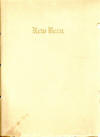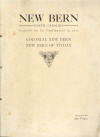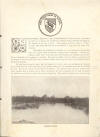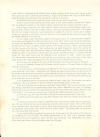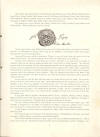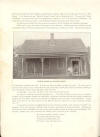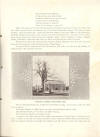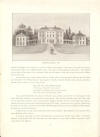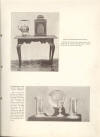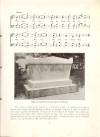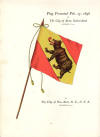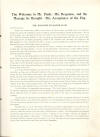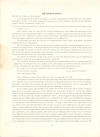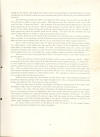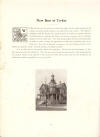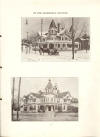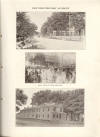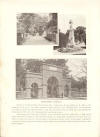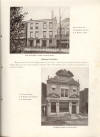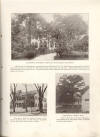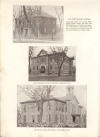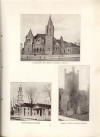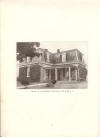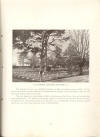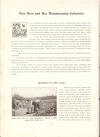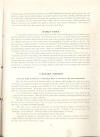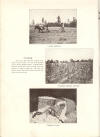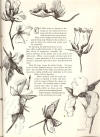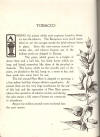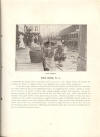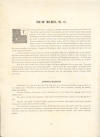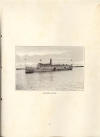
New Bern, North Carolina
Founded by De Graffenried in 1710 (1905)
Bibliographic information: Powell, Emma H. New Bern, North Carolina Founded by De Graffenried in 1710: Colonial New Bern, New Bern of To Day (New Bern, N.C.: n.p., 1905), 33 p. An early, illustrated history of New Bern that also includes information on several New Bern businesses in 1905.
[Click on an image to enlarge that image.]
[Front Wrap]
New Bern
[Title Page]
New Bern
North Carolina
Founded by De Graffenried in 1710
Colonial New Bern
New Bern of To Day
Copyrighted in 1905
by
EMMA H. POWELL
[Page 1]
"Der Stadt Bern in Siegel" [Illustration Seal of Bern]
CHRISTOPHER EMANUEL DE GRAFFENRIED, a citizen of Bern, Switzerland, the elder son of Antony De Graffenried, a follower of the great Duke Berchthold V, the founder of the city of Bern. This ancestor built the castle of “Worb,” six miles from Bern, and inherited by Christopher in 1730, after his return from America.
Christopher De Graffenried is described as a very handsome and fascinating man, and a great friend and favorite of Queen Anne, of England. Upon his purchasing a large tract of land from the Lords Proprietors of Carolina, she made him Baron of England and a Landgrave of Carolina. His patent of nobility, written in Latin on parchment, and his insignia of rank, his golden star with its obscure heraldic devices, and his seal are in possession of one of his lineal descendants.
De Graffenried leaving his native land for England in October, 1709, and purchasing ten thousand acres of land from the Lords Proprietors for ten pounds sterling for every thousand acres, and five shillings quit rent. He sent out a colony of 650 Palatines for America. He appointed three directors, notables from North Carolina, then in London, one of whom was Lawson, the surveyor-general; for he could not himself sail with them, as he had to wait for his colonist from Bern. They landed in Virginia, and traveled by land
[Illustration of Lawson's Creek]
LAWSON’S CREEK
[Page 2]
to Col. Pollock’s, in Albemarle on the Chowan, thence to Bath, and thence to the Neuse, where Lawson located them on his own lands on the Trent, and sold them a tongue of land between the Neuse and Trent Rivers, called Chattawka, where afterwards they founded the small city of New Bern.
De Graffenried afterwards bought this tongue of land from the Indian King Taylor.
In June, 1710, De Graffenried joined the Swiss Colony at New Castle, England, and sailed for Virginia. Only one shipload is mentioned, so the number of Swiss could not have been as large as sometimes stated.
After a happy voyage they were safely landed in Virginia, and came as did the Palatines, finally reaching New Bern. There a “sad state of things, sickness, want and desperation greeted them.” De Graffenried's life was in danger, but he set to work energetically to establish the colony in comfort, and in eighteen months they managed to build homes and make themselves so comfortable that they made more progress than the English inhabitants in several years.
In 1711, taking 15 days’ provisions, 2 negroes to row, and for safety two well-known Indian neighbors, one of whom spoke English, De Graffenried started up the Neuse River with Lawson for general exploration. No danger was apprehended, for no savages lived on the river. Landing at a spring not far from the village Coertha, they were met by a number of armed Indians, who took them prisoners. They took De Graffenried to be the Governor of the Province. After marching them all night through the woods, they reached the village, Catechena, where King Hencock was sitting with his council around him. After consulting with the neighboring tribes, it was decided to liberate them, but Lawson, becoming involved in a quarrel with the Indian Cor Tom, both Lawson and De Graffenried were condemned to death. Lawson was massacred, and the Baron imprisoned for six weeks and then was permitted to return to his home in New Bern, where he found the Indians had pillaged the town and many persons killed and taken prisoners.
But soon peace and prosperity once more perched her banner upon this people, and New Bern grew.
In 1713 De Graffenried, having lost his fortune, sold his interest to Thomas Pollock for 8oo£ and returned to Switzerland.
In 1710 came a colony of Welch Quakers and settled below New Bern, on Clubfoot and Hancock creek, on the south side of the Neuse. Among these were Thomas and John Lovick, the latter of whom was one of the North Carolina Boundary Commission in 1728 to settle the line between Virginia and North Carolina. New Bern, named for Bern, Switzerland, is beautifully located at the confluence of the Neuse and Trent Rivers, and is one of the oldest towns in the State.
It was probably laid off by Lawson and Col. Pollock in May or June, 1710. It was called New Bern in compliment to Bern, the birthplace of both De Graffenried and Mitchell, leaders of the colony.
At the foot of Broad Street was formerly a hill called “Council Bluff.” Here in solemn assembly around their blazing council fires, the revengeful savages under King Taylor, deliberated war, peace or vengeance. Between this dread spot and the foot of Craven Street is said to lie the location of the original settlement of the “City of Elms.” So was born the second town in North Carolina, Bath having been laid out in 1705.
In November, 1723, New Bern was made a township and soon became the capital of the colony.
In 1738 the General Assembly met on the 6th of March in New Bern and continued its sessions there for years.
In 1749 James Davis, from Virginia, established in New Bern the first printing press in North Carolina. The laws hitherto had been only in manuscript, and much confusion had resulted. After careful revision by the Legislature they were printed in 1752 by James Davis and bound in a small folio volume in yellowish and unskillfully tanned leather, hence always known as “yellow jacket.” His printing office was on the corner of Broad and East Front Streets.
In 1754 Arthur Dobbs was appointed Governor by the Crown, and in the fall arrived at New Bern and was qualified on the 1st of November. Gov. Dobbs’s administration of ten years was a continued contest between himself and the Legislature on matters frivolous and unimportant. Gov. Dobbs died at his seat in Town Creek, 28th March, 1765, in the eighty-second year of his age.
[Page 3]
The persons who composed his council during his administration were: James Hassel, Matthew Rowan, James Murry, Francis Corbin, John Dawson, Lewis H. De Rossett, John Rieussett, James Jones, John Swann, John Rutherford, Richard Spaight, Edward B. Dobbs, Charles Berry, John Simpson, Henry F. McCullock, Alexander McCullock, William Day, Robert Palmer and Benjamin Herron.
The Judges were: James Hassell, Peter Henly, Charles Berry, George Nicholas, Joseph Anderson and Charles Elliott. Thomas Childs was Attorney-General.
[Illustration of a seal and signatures of Wm. Tryon and John Hawks]
On the 27th October, 1764, William Tryon arrived in North Carolina with a commission as Lieutenant-Governor. In Wilmington on the 3rd April, 1765, he was qualified as Commander-in-Chief and Captain-General of the Province of North Carolina.
Governor Tryon was a soldier by profession. Trained to arms, he looked upon the sword as the true sceptre of government. Yet with the character of the soldier he mingled that of the politician.
He knew when “discretion was the better part of valor,” and when to use such force and cruelty as attained for him from the Cherokee Indians the bloody title “Great Wolfe of North Carolina.” He could use courtesy towards the Assembly when he desired large appropriations for his magnificent palace, and knew how to bring to bear the blandishments of his charming wife and her beautiful sister, Esther ‘Wake, a noted belle. They had all the social desires of admired and petted women, and with them to direct matters, the Governor’s receptions took on the semblance of court functions. While his character shows that on the banks of the Alamance, when “the blast of war blew in his ears,” he could, by his ferocious and bloody conduct, imitate the "action of the tiger.”
For six years he ruled the State with the temper of a despot and the rod of a tyrant. He was transferred as Governor to the Colony of New York. James Hassell, being the first named of the council, on the departure of Gov. Tryon, was qualified as Governor in July, 1771. He soon resigned the reins of government to Josiah Martin, who had been commissioned by the Crown, and who arrived in North Carolina, at New Bern, on the 11th August. Gov. Martin was by profession a soldier. He was an Englishman by birth and a major in the British Army. Gov. Martin met the Legislature the first time in the town of New Bern in November, 1771.
In 1773 John Harvey, Speaker of the House; Robert Howes, Cornelius Harnett, William Hooper, Richard Caswell, Edward Vail, John Ashe, Joseph Hewes and Samuel Johnson were appointed a committee to inquire into the encroachments of England upon the rights and liberties of America.
The first Assembly independent of royal authority was at New Bern on the 25th August, 1774. This Assembly, or Congress as it was called, is an epoch in our history. It was not a conflict of arms or force, but it was the first act of that great drama, in which battles and blood formed only subordinate parts.
At this Congress, Craven County was represented by James Cooke, Lemuel Hatch, Joseph Leech and Richard Cogdell.
The Assembly approved of the plan of the General Congress at Philadelphia in September, and elected as members, William Hooper, Joseph Hewes and Richard Caswell.
The Colonial Assembly was called in April, 1775, at New Bern, at which time both bodies met. After a session of four days Gov. Martin dissolved the Assembly and here terminated the royal rule of England. Gov.
[Page 4]
Martin took refuge first in Fort Johnson, and afterward on board a ship of war in the Cape Fear river, “The Cruiser.” Gov. Martin, after the “Battle of Moore’s Creek,” left for Charlestown, S. C. He was at the “Battle of Guilford.” Soon afterwards he went to England, but returned to New York and died at Rockaway. He was the last of the Royal Governors. The Provincial Congress was held at New Bern in 1776.
In 1778 it was said that New Bern was the metropolis of North Carolina, and contained 150 houses.
Morse says in 1792: New Bern is the largest town in the State. Contains 400 houses, all built of wood, excepting the palace, the church, the gaol and two dwelling houses, which are of brick. The Episcopal Church
[Illustration: "The Oldest House in Craven County"]
is a small brick building with a bell. It is the only house of public worship in the place. The court house is raised on brick arches, so as to render the lower part a convenient market place; but the principal marketing is done with people in their canoes and boats at the river side.
In September, 1791, near one-third of the town was consumed by fire.
In 1819 the American Universal Geography says: The public buildings are three houses of religious worship, for Episcopalians, Baptist and Methodists, a handsome court house and jail, all of brick; a theatre, an academy and two banks. The town has increased in eighteen years from 2500 to 4000 inhabitants. A large trade was carried to the West Indies and the different States in barrels of tar, pitch, turpentine, lumber, corn, etc.”
A steamboat intercourse is established between New Bern and Norfolk. The steamboat “Norfolk” was bought by a New Bern Company, William Nash, President, and Stephen M. Chester, Secretary. The boat was run from New Bern to Elizabeth City, and was the first steamboat owned in the State, and cost $85,000. The Secretary, Chester, was a poet, and wrote the following lines on arrival of the Norfolk”:
“We could not speak, or think or dream
Of anything but boats and steam.
At length the gilded bauble gave
Its beauty to the expectant wave-
[Page 5]
Had Cleopatra’s barge appeared
It had not been more gaily cheered.
Hundreds flocked down to see the wonder
In spite of rain or even thunder;
And such enrapture to possess it
‘Twas not in language to express it.”
Many of the great men in North Carolina and the United States were born or lived in New Bern. This fact, with its previous history and influence, gave New Bern the honorable sobriquet, “The Athens of North Carolina.” These were palmy days. Many whom the State delight to honor had walked or still walked these beautifully shaded streets, graced society and had commercial and political fame. The names of Coor, Hatch, Bryan, Xavier Martin, Gov. Nash, two Governors Spaight, Stanly, Gaston, Sitgreaves, Graham, Shepard, Badger, Washington, Manly and many others of whom New Bern has just cause to be proud.
The first steam mill in New Bern had been erected by William Shepard in 1812, from prize money he had received from successes of the celebrated privateer “Snap-Dragon.”
A castor oil factory, turpentine and rosin-oil distilleries, grist mills, saw mills and ship building all adding greatly to the prosperity of the city.
[Illustration "EPISCOPAL CHURCH AND FOREST TREE"]
The new Episcopal Church was completed by Benet Flanner in 1824. It was burned in 1871 and rebuilt as it now appears.
The Baptist Church, on Middle Street, was first used and dedicated 2nd July, 1848.
The Methodist Church, on New Street, was built in 1842-43.
The Presbyterian Church was dedicated in 1821.
A sketch of New Bern, however brief, without some account of "Tryon’s Palace,” would not be complete. A square of six acres was selected, bounded by Eden, Metcalf and Pollock Streets, and Trent River. Brick and prepared material were brought from England, and John Hawks, a Moor from Malta, who was
[Page 6]
[Illustration of "Tryon's Palace--1770"]
educated in England, was employed on a salary of $600 as the architect. The contract was made 9th January, 1767, and the Palace was completed October, 1770. The main or center building is the Palace. The building on the right of the picture is the Secretary’s office and the laundry, while that on the left served for kitchen and servants’ hall.
Over the inner door of the entrance hall was a tablet with a Latin inscription, showing that the Palace was dedicated to Sir William Draper, “the conqueror of Manila ;“ also the following lines, in Latin, written by Draper, who was then on a visit to Gov. Trvon:
“Rege Pio, felix, dires insinica tyrannis,
Virtute has Aedes liber a terra dedit
Sent domus et dominus saeclis exempla futuris
Hie artes, mores, Jura, legesque colant.”
It was said that the third story, shown in the plate, was omitted, and that the roof had parapet walls with a balustrade around it, was made flat for a promenade. From this roof looking towards the Trent could be seen Cleremont, the home of the Moores and the Spaights; beyond it the home, of the Bryces and Gastons, with the division of a creek only, Pembrooke, the home of the Nashs. Cleremont is now owned by Judge Henry R. Bryan, of New Bern. Both Governor Richard Dobbs Spaight and his son, Governor Richard Dobbs Spaight, are buried in a vault at Cleremont.
At Pembrooke is an old vault in which Gov. Abner Nash is buried. This plantation is now owned by Miss Laura Whitford, of New Bern.
It would be impossible in a short sketch like this to enumerate in full the many points of historical interests in and around New Bern, but there are a few objects of more than ordinary importance which would interest the sightseer.
[Page 7]
RELICS FROM TRYON’S PALACE
The table and clock in the picture are now owned by Hon. C. C. Clark, and the silver tea-kettle by Mrs. M. D. Nelson of New Bern.
COMMUNION SERVICE OF THE EPISCOPAL CHURCH
This Communion Service and Alms Basin were presented by George II to this parish in the latter part of his reign. A Bible and Book of Common Prayer were given at the same time. The Bible was printed in 1717 (George I). On the covers are the full coat of arms of Great Britain. Upon the back of the Prayer Book in monogram are the letters G. R., surmounted by a crown.
[Page 8]
The Old North State. A Patriotic Song
Written by the late Wm. Gaston of North Carolina
Harmonized by Francis X. Hale.
1. Carolina, Carolina, Heaven's blessings attend her, While we live we will cherish, protect and defend her Tho' the scorner may sneer at and witling defame her, Yet our hearts swell with gladness whenever we name her.
2. Tho' she envies not others, their merited glory, Say whose name stands the foremost in Liberty's story; Tho' too true to herself e're to crouch to oppression, Who can yield to just rule a more loyal submission?
3. Plain and artless her Sons, but whose doors open faster, To the knock of the stranger or tale of disaster; How like to the rudeness of their dear native mountains, With rich ore in their bosoms and life in their fountains.
4. And her Daughters the queen of the forest resembling, So graceful, so constant, to gentlest breath trembling; And true lightwood at heart, let the match be applied them, How they kindle in flame--oh! none know but who've tried them.
5. Then let all who love us, love the land that we live in, As happy a region as on this side of heaven, Where plenty and freedom love and peace smite before us, Raise aloud , raise together the heart thrilling chorus.
[Page 9]
Chorus.
Hurrah, Hurrah, The old North State forever,
Hurrah, Hurrah, The good old North State.
[Illustration "Tomb of Gaston in Cedar Grove Cemetery"]
Wm. Gaston was born in New Bern, N.C., on September 19, 1778. He studied law in the office of Francois Xavier Martin, and before arriving at manhood was admitted to the bar, in 1798. He served his State in many capacities with distinction. In 1834 he was elected Judge of the Supreme Court, which position he held until his death, which occurred on January 23, 1844. Truly was it said by one who knew him long and knew him well, "He was a good man and a great judge." His taste for poetry was of a elevated character. He was the author of "The Old North State Forever."
[Page 10]
Flag Presented Feb. 27, 1896 by The City of Bern, Switzerland Founded in 1191 to The City of New Bern, N.C., U.S.A. Founded in 1710
[Illustration of the flag of Bern and New Bern, red and yellow superimposed with a bear.]
[Page 11]
The Welcome to Mr. Pioda—His Response, and the Message he Brought—The Acceptance of the Flag
THE WELCOME BY MAYOR ELLIS
YOUR EXCELLENCY:
Nearly two centuries ago, within a stone’s throw of this hereafter memorable hail, your illustrious countryman, Baron De Graffenried, whom we hold in grateful remembrance, landed on these shores. He was met by a people, who, when their Great Spirit moved them, were well versed in extending a very warm reception. Amid the charming shrillness of the war-whoop, the fascinating twang of the bow, the magnetic flight of the barbed arrow, the skilled and finishing strokes of the tomahawk, and, sometime, “the tripping of the light fantastic toe,” they welcomed their guest to a feast, somewhat notable for its vehement, boisterous beginning, and calm, quiet, still, though ominous termination.
Civilization, your Excellency, with the arts and sciences, education and religion, has, since that time, wrought many marvelous changes. You, sir, are the distinguished representative of these brilliant achievements, on the other side of the water, whence De Graffenried came, and we, a more humble one, on this side, where De Graffenried landed.
Old Bern was then being rocked in the cradle of republican institutions, while New Bern, when De Graffenried named her, had a local habitation only amid the untouched forest trees of the scarred and printed red man. Old Bern, the capital of the sweetest, most delightful, most romantic, most touchingly reminiscential spot on the map of all the European domain, has kept elastic step to the music of the centuries, and, to-day, holds her head erect, with radiant and sparkling eyes, amid the culture and learning, the magnificence and splendor of the great cities of the world.
New Bern, the little daughter, has done her best, your Excellency, to emulate the example of her dear old mother; and here, now, at the placid confluence of the same old rivers, the Neuse and Trent, over whose bosoms the early Swiss settlers sailed many a time, and dreamily meditated on the pregnant future, she nestles herself, rejoicing in her strength, her beauty, her attainments, her promise, and above all, in the potent fact, that she is an essential, integral part of this great government, which freely dispenses its blessings and privileges on every foot of earth that lies between Canada, on the North, and the Gulf of Mexico on the South, the Atlantic on the East, and the Pacific Ocean on the West; the germs of which were so beneficently scattered, when the Swiss settler planted his feet on the shores of the “Old North State.”
Your Excellency, we congratulate that government, “The United States of America,” on having you as the illustrious diplomatic representative of the unchanged and unchangeable republic of Switzerland, where the liberty, which the Swiss ever adored, never trembles in the midst of the unrest of surrounding European dynasties.
But above all, sir, the honored and delighted citizens of New Bern, congratulate themselves on having you, “fittingly clad, as you are in the robes and honors of your high diplomatic station,” as the representative of the fond remembrance and kind wishes of Old Bern, he mother, to New Bern, the still growing and affectionate daughter.
Standing here, as I do, sir, the Mayor of the City, the accredited representative of New Bern, her old men and her young men, her old women and her young women, her boys and her girls—I extend to you a welcome very unlike the welcome of the olden time—from her heart of hearts. Your distinguished and benignant presence has captured the city. It is yours, sir, take it. It belongs to you, of rights. This day, the daughter is locked in the fond embrace of the mother. New Bern is the willing captive of Old Bern, and with glad acclaim, she shouts Welcome! Welcome! thrice Welcome! to you, Your Excellency, and the unique occasion that brings the two Berns together after such a long and anxious separation.
[Page 12]
MR. PIODA'S REPLY
MR. MAYOR, LADIES AND GENTLEMEN:
I am charged by the Council of Burghesses of Bern with the honor of delivering to you, Mr. Mayor, the Banner of Bern. The above mentioned Council joins with this symbol of the old City the following address, which I am pleased to read to you:
The Council of Burghesses of the City of Bern to the Mayor, City Council and Citizens of New Bern, North Carolina, U. S. A.
SIRS :—When, in the year 1891, the City of Bern celebrated the seven hundredth anniversary of her foundation, it was with gratification that we were enabled to welcome amongst our guests the Mayor of the City of New Bern, founded by a Bernese in the XVIII century, and which, mindful of its old Bernese origin, deputed its highest magistrate to take part in the festivities of its mother-city.
We felt greatly honored by this proof of true attachment and friendly feeling on the part of the distant daughter-city in the United States.
The City Council of New Bern, having, in 1894. decided to adopt the armorial bearings and colors of our town, in lasting memory of the original kinship, the Council of Burghesses of Bern at the request of an eminent Burgher, Mr. George von Benoit, resolved to present you with a banner displaying the arms of our City and the date, 1891, in remembrance of the celebration of that memorable anniversary and of the birth of friendly relations between the two cities on this occasion.
We transmit herewith this symbol, now common to Swiss and American Bern, and accompanying it with our hearty wishes for the growth and prosperity of your city.
The Council of Burghesses of Bern is convinced that the Bernese banner will win as great respect and high honors on the other side of the Atlantic, in the United States, as it did in its old home, and will prove the means of keeping alive the feeling of relationship of the two cities for generations to come. We remain, sirs, with sincere greetings in the name of the Council of Burghesses,
DR. R. STETTLER, Secretary. A. VON MURALT, Chairman.
BERN, 28th January, 1896.
The remembrance of this mission will be one of the most agreeable of my life.
Although not a Bernese myself, I spent a good part of my early youth in Bern and so had the opportunity of acquiring a more intimate knowledge of the City, its people and their history, and to observe the dignity and loyalty with which Bern surrounds the Supreme Powers of the Confederation, and how deservedly this noble City has been honored by the whole country, thereby indicating its trust in her.
In the twelfth century, after feudalism had reached the summit of its power and its decline was beginning, emperors and kings relied upon a new awaking force, the people, in order to restrain the nobility. Thus the Duke of Rachringen founded in 1191 the City of Bern in order to hold in check the Burgundian nobility and the City become a mighty stronghold for liberty. Many struggles for life and death had she to maintain against nobility, empire and foreign powers, and therefore the white color of the banner was changed to blood-red. But every battle found Bern stronger than before. Love of liberty inspired its brave citizens, wise and energetic statesmanship directed its government. As long as these virtues were kept awake in the City, Bern’s power and welfare flourished. Her accession in 1353 to the Confederacy to the early Cantons turned to mutual profit and effected the joining of other members to the Union until Switzerland during the European wars of the fifteenth century, attained the position of a great military power; to which Bern especially contributed. But, although glorious, this position was not beneficial either to Bern or to the Confederation. Therefore both, the latter as well as the former, adopted another policy, namely, the policy of neutrality in such European questions as did not concern Switzerland directly. Switzerland persevered in this policy, and after Bern and the Swiss Confederation having weathered the great political storm at the close of the last and at the beginning of the present century, the old City now stands regenerated and flourishing, crowned as the
[Page 13]
Capital of a free nation. The nimbus of her glorious history surrounds Bern’s proud head and her eyes look courageously and trustfully towards the future foreseeing nobler laurels. The bear, as you see, strides upwards! Excelsior!
The noble Berna educates her children to be virile, that their courage may be as firm as the Alps and their patriotism as sublime as those snowy peaks. With vigorous arms they wield the sword. But on the sword is written : “Liberty and Justice.” Only in defense of the sacred soil of Switzerland and for a just cause Bern will allow the sword to be drawn. Therefore Berna endeavors to instill among her children the love of Justice, for they observe justice towards all and will not tolerate injustice from any one. They are taught to decide questions by lawful and peaceful means and not violence. For Berna has the conviction that man cannot consider himself as civilized so long as he permits violence of arms.
Therefore Bern gives in the councils of the Confederation her influential vote for all those initiatives which contribute to the unfolding of peaceful relations between nations and which make of Switzerland something more than a great military power, that is to say, as it has already been called, a great moral power.
Every member of human society, and every people among the nations of the world must have ambition for a noble purpose. In the Middle-Ages Bern and the other members of the Confederation endeavored to secure liberty by developing military strength. Now their commonwealth being free, strong and highly esteemed by all nations, they endeavor to make its power felt in furthering the progress of the general civilization of mankind and try not to be behind those nations which are farthest in advance in this direction.
What were the words of the great-hearted father of this great country to his fellow-citizens in his farewell address?
“Observe good faith and justice towards all nations; cultivate peace and harmony with all. Religion and morality enjoin this conduct; and can it he, that good policy does not equally enjoin it? It will be worthy of a free enlightened, and, at no distant period, a great nation, (he has been a good prophet), to give to mankind the magnanimous and too novel example of a people always guided by an exalted justice and benevolence. Who can doubt, that, in the course of time and things, the fruits of such a plan would richly repay any temporary advantages, which might be lost by a steady adherence to it? Can it be, that Providence has not connected the permanent felicity of a Nation with its virtue? The experiment, at least, is recommended by every sentiment which ennobles human nature.”
Noble old City beyond the sea, surrounded by the Jura and the Alps! Thou returnest in handing over thy glorious banner the greetings which thy daughter brought to thee on thy seven hundredth birthday and the homage she rendered to thee in assuming thy colors and symbol.
Noble City, thou mayst be trustful: Thy banner is well kept and well preserved in the country where Washington’s noble words are still living—words which are in harmony with thy endeavors.
Citizens of New Bern: When the Bernese, Christopher de Graffenried, founded your city, it was standing here as a dangerous out-post of civilization at a time when savages still held possession of the country Your ancestors contributed to make this beautiful and great country habitable, and then free. You will be loyal to this banner if you, mindful of its and your origin, shall keep awake the love of liberty and justice which is common to the Cities of Erlach and Hailer, to the country of Tell and Pestalozzi, as well as to the country which Washington founded and which Lincoln ennobled and preserved.
Mr. Mayor, citizens of New Bern: Let this banner fly under the shadow of the star spangled banner; both lead to the peaceful struggle for the welfare of mankind.
[Page 14]
New Bern of To-day
WINTER and Summer, the whole year round, New Bern and its vicinity possess for the stranger attractions hardly known in any other part of the country. The climate is delightful, with the breezes from Pamlico Sound to temper its Summer and from the Gulf Stream to moderate the Winter, all out-door exercises can be constantly engaged in for the entire year. New Bern is a good place to live in, and a good place in which to make a living-—the opportunity to make money and also to enjoy it are both here. New Bern is destined to become a favorite Southern Winter resort. Health and pleasure seekers will find hunting and fishing excellent.
It is an ideal field for the gunner, angler and yachtsman. The growth and development of New Bern has been steady and satisfactory. True, she owes her prosperity, in large measure, to the natural position she occupies, located at the junction of the Neuse and Trent Rivers, and to-day the City founded by De Graffenried contains a population of over 13,000 souls.
[Illustration of the Duffy House, sw cor Broad and East Front, demolished in the 1950s]
[Page 15]
[Illustration of the W.B. Blades house, ne cor Middle and Johnson Streets]
[Illustration of the Stewart House, ne cor Pollock and Craven Streets, demolished in the 1960s]
[Page 16]
"Negro Baptism"
[East Front Street showing the Nelson House]
"Steamer Neuse"
"View of Neuse River and Bridge"
"View of Neuse River"
[Page 17]
New Bern Military Academy
"Rear View of Main Building"
[Formerly located on George Street, burned in the fire of 1922]
[Page 18]
Cedar Grove Cemetery
Opened A.D. 1800 by Christ Church, New Bern. Transferred by the church A.D. 1854 to the authorities of the town. One unique attraction of this cemetery is the "Weeping Arch" of the gateway. It is built of a curious formation peculiar to New Bern and vicinity, known as shell rock, which absorbs and retains rain and then allows it to drop gradually, thus earning its name.
The monument in Cedar Grove Cemetery to the Confederate dead was erected May 11, 1885, by the Ladies' Memorial Association. The monument consists of a large block of granite for its base, and on it blocks of marble surmounted by a life-size statue of a Confederate soldier "at rest" on his musket. Beneath the monument in a large tomb are the remains of many soldiers who were killed in battle around New Bern or who died in hospitals.
[Page 19]
The National Bank of New Bern
James A. Bryan, Pres.
J.H. Blackburn, Vice-Pres.
G.H. Roberts, Cashier
Banking Facilities
There are two solid, well-managed banks in New Bern. These banks are liberal, and have plenty of surplus cash, and every accommodation consistent with sound banking can be secured by manufacturers at a low rate of interest.
Citizens Bank of New Bern
T.A. Green, President
E.H. Meadows, Vice-President
T.A. Uzzell Cashier
[page 20]
Pollock Street, Looking Towards Neuse River
Pollock Street, Looking East, New Bern, N.C.
Court House
Government Building
[Page 21]
Residence of James A Bryan, Formerly Residence of John Stanly
In this house George Washington was entertained when in New Bern in 1791. Mr. Stanly also here entertained Gen. Nathaniel Green when his army was famished and half naked and Gen. Green knew not what to do. Then Mr. Stanly loaned him forty thousand pounds for his suffering heroes. On passing this house, Hon. Edward Everett lifted his hat and said: "Once the home of patriots and statesmen."
[Lower left] This house, which was formerly the home of the late Mr. Frederick Jones, was used during the occupation of New Bern by the Federal Army as a prison.
[Lower right] Historical Cypress Tree
Under its shade have stood General Washington, General Nath. Green, John Wright Stanly, the Spaights, and Hon. Edward Everett.
[Page 22]
New Bern Graded School was erected in 1806. In it Gaston, Stanly, Badger, Spaight, Hawks, and many other distinguished sons of Carolina were educated. This school was incorporated originally in 1766, but was burned in 1795, and the present building was erected in 1806.
New Graded School Building, Erected 1904
Graded School Building, Erected in 1886
[Page 23]
Centenary Methodist Episcopal Church
Presbyterian Church
Middle Street Baptist Church
[Page 24]
"Lodge," U.S. National Cemetery, New Bern, N.C.
[Page 25]
U.S. National Cemetery, New Bern, N.C.
The National Cemetery was established February 1st, 1867, and contains 7-1/2 acres of land. it is situated on the National Avenue (built by and maintained at the expense of the Government) about one mile north of the railroad station in New Bern.
There are 3353 graves, representing 20 States, 1100 unknown are buried here. Some of the burials were made originally here. The remains of the greater number were, however, removed from the places of original interment, viz: Old Cemetery at New Bern, Beaufort, N. C., Morehead City, Kinston, Hatteras, Roanoke Island and many other places along the coast of North Carolina.
[Page 26]
New Bern and Her Manufacturing Industries
WE can consistently boast of possessing as many manufacturing plants, cotton mills excepted, as any town of our size, and point with a degree of pardonable pride to our many lumber and planing mills, factories for working lumber into specialties, iron works and machine shops, fertilizer factories, knitting mills, packing houses, carriage works, marble and building stone works, ice plant, cotton gins brick plants, cotton seed oil mill, bottling works, canning factory, basket and barrel factory, etc., etc.
In the city of New Bern, and within sight of its steeples, 13 saw mills are now running, whose joint output of dressed and undressed lumber reaches 125,000,000 feet per year. Some of these mills have a capacity of 40,000 feet per day. They have drying kilns and planing mills attached to them, and use all the latest mechanical improvements. Adding several saw mills a little distance from town, the annual shipments must reach 125,000,000 feet. Large tracts of proximate timber of all sorts peculiar to the soil remain uncut and available. These include no less than 8o varieties of furniture and other economic woods.
A more favored location for manufactories cannot he found in the South. Raw material exists here in abundance.
Its superior advantages as a shipping point, and the enterprise, energy and public spirit of its citizens and business men of prominence and influence are factors that may be relied upon for commercial progress and general prosperity.
To prospective settlers and investors there is no Southern town which offers better advantages than New Bern. She has free mail delivery, superior water works and sewerage, electric light and gas plants, fine graded schools, excellent fire department, good telephone service, a handsome public building and county court house, churches of all denominations—in fact all the conveniences essential to the happiness and comfort of a people.
PRODUCTS OF THE LAND
There is no part of the Atlantic coast where cereals, grasses, vegetables, fruits, melons, and root crops can be raised more easily and abundantly than in this section Soils are of great diversity and of every degree of fertility, from the black muck of the drained swamps to the white sand of the beach dunes, and not a stone is to be seen anywhere. Here are stiff lands, producing wheat, corn, berries and fruits of certain kinds; loose lands, yielding peas, peanuts, sweet and Irish potatoes, melons, strawberries, grapes and garden truck in great variety; gray sandy clay, which produces the best cotton; white sandy soil, favoring
[Illustration: "Scene on one of the Prominent Truck Farms Near New Bern, N.C."]
[Page 27]
long straw pine, corn and cotton; clay loam, very fertile; alluvial soils for grasses, grain and roots; also very fertile low, sandy loam, producing grapes and peaches; natural swamp lands, affording cranberries and reeds for cattle fodder; reclaiming lake and swamp lands, producing corn, peas and apples of excellent flavor; peat lands for fertilizer and fuel; white beach sand, yielding Yopon tea, pine and grapes; black vegetable mould, richest of all; and so on, through every grade of admixture and chemical combination. Out-cropping of yellow marl and shell rock often protrude from river cuts and elevations.
MARKET TRUCK
No agricultural districts in the United States are worked with more intelligence and profitable outcome than the truck farms around New Bern. Four thousand acres at least are in the highest state of cultivation, with a diversity of products which covers the entire range of the seedman’s catalogue. Most truckers produce four different crops from the same acreage every year, aggregating in a good year $200 to the acre. Cabbage and kale are shipped all winter. Lettuce and radishes go out in February, asparagus in March, and the rest follow. The total annual shipments reach a quarter of a million of packages, of which perhaps 100,000 are Irish potatoes, which are dug early in June. Such is the wonderful character of this industry that, great as it already is, every year seems to add to its marvelous development and expansive area.
The mild weather of the. Pamlico Section enables the farmer to work twelve months in the year; it reduces the cost of live stock raising to the minimum, and cattle can find good grazing for a large part of the year. It makes the fuel bills for farmers an inconsiderable item, and it obviates the necessity of heavy clothing and many other expenses absolutely necessary in all cold countries. Thus the Southern farmer’s capital not only yields him two dollars for every dollar returned to the Western farmer for his capital, but added to this there is a difference in the cost of living, which is so great that it must command wide attention as it becomes more fully understood.
A NOTABLE INDUSTRY
THE NEW BERN COTTON OIL & FERTILIZER MILLS A FACTOR OF THE CITY’S PROSPERITY
The New Bern Cotton Oil & Fertilizer Mills is an industry which perhaps few people know about. It is situated at considerable distance from the centre of the city, and the work is of a nature that does not create the interest that a manufacturing establishment of as large proportions but turning out a different class of goods would create. At the same time it must be admitted that the New Bern Cotton Oil & Fertilizer Mills is as important an industry as the city has within her corporation.
As is well known the company formed several years ago, was re-incorporated in 1903, taking into the company several new members. Since that time they have been remodeling, enlarging and building anew until now they have a plant of very large proportions.
The plant itself has reached a stage that the company deems adequate to meet the demands that will be made on it for a good many years to come. It is one of the largest concerns in Eastern North Carolina, and enjoys a constantly increasing patronage.
The cotton seed, of which they always have an enormous amount on hand, is converted into oil at the rate of 120 barrels per day; cotton seed meal, 20 tons per day. A portion of the seed also goes to the manufacture of the fertilizers. The daily output of the fertilizer factory is 100 tons.
The company have their own electric light and water works system.
Altogether the industry is a splendid feature of New Bern’s commercial standing and prosperity. Though little has been said of the operations of this concern, their business is as large as any corporation in the city.—New Bern Journal, Nov. 7, 1904.
[Page 28]
COTTON
The crop in the South that surpasses every other in value is cotton. It is one of the principal crops in Eastern North Carolina. Counting what is marketed in New Bern and the nearby towns the aggregate is 25,000 to 30,000 bales. The body and staple of cotton raised in this section is first-class and is free from dust and sand.
“A CROP CRITTER”
NEGROES PICKING COTTON
“TAKING A NAP”
[Page 29]
COTTON seeds are planted in the spring, in rows about three feet apart, and the weeds are kept out until the plants are nearly grown.
They reach a height of about three feet, and develop large blossoms that produce a pod in which the cotton and cotton seed are contained.
On maturing, the pod bursts open, revealing a white woolly ball, known as the cotton boll, which in appearance resembles the downy substance in the thistle and in the pod of the milk weed. When a great number of these pods have opened, a cotton plantation of five or six hundred acres presents a beautiful sight, much like a field flecked with snow
Then the busy season for pickers begin. As many as two or three hundred negroes—men, women and children—may assemble in one field, carrying bags and picking cotton, singing melodies and chattering in the negro dialect the live-long day.
When plucked from the pods, the cotton is attached to seeds, and these must be removed before the cotton can be of use. The seedless cotton is tightly pressed into bales of about 500 pounds, which are then covered with coarse jute bagging bound with iron bands, and shipped away to the warehouses to be sold.
[Illustrations of Cotton plants, flowers, and bolls drawn by Bayard Wootten.]
[Page 30]
TOBACCO
AMONG the plants which early explorers found in America was the tobacco, The Europeans were much astonished to see the savages smoke the dried tobacco leaves in pipes. Soon the new-corners learned to smoke also, and tobacco became one of the leading products shipped to Europe.
The plant, which grows to a height of about three and a half feet, has thick leaves which are large and broad, somewhat like those of the pie-plant or rhubarb. The leaves, which are the valuable part of the plant, are plucked in the fall, hung in a room to dry, and then made into some form for use.
The soil around New Bern is adapted to growing a a fine yellow leaf that always obtains a good price. At present there are two very large warehouses for the sale of this leaf, and the reputation of New Bern grown tobacco has spread to all tobacco centres, and during the sales season a full corps of buyers are constantly in attendance.
About one million pounds were marketed here the past season.
[Illustration of a tobacco plant drawn by Bayard Wootten.]
[Page 31]
New Bern, N.C.,
is undeniably the leading market in the State, and we may say on the Atlantic Coast, with possibly the exception of Norfolk, for supplies of fish of every palatable variety, oysters, clams, terrapin, etc.
No less than eighty varieties of salt water and fresh water fish have been shown at the New Bern Fairs at a single exhibit, all taken from neighborhood waters, and supplemented by nineteen varieties of oysters, and an attractive assortment of clams, crabs, scallops, mussels, terrapins, and crustaceans. Seventy-five thousand packages of fish, packed on ice, go out from New Bern every year. Fully 2,000 persons are employed, and a great number of nets, boats, seines and vessels. Enormous quantities of shad, sea trout or weakfish, red drum, mullets and herring, are caught in fall and spring, with bluefish, Spanish mackerel and various other varieties, more or less valued, at different seasons. Many varieties of fish, anadromous and stationary, spawn in the rivers, creeks and estuaries. Myriads of pelagic fish pass to and fro from the ocean with the diurnal ebb and flood; fluxes which keep the landlocked waters pure, and insure the health and welfare of all who dwell upon their shores.
FISH MARKET
[Page 32]
NEW BERN, N. C.
THE City of New Bern is situated in a triangle formed by the junction of the Neuse and Trent Rivers, and has direct communication, not only with the Atlantic Ocean, but all portions of the State by water and rail, and with every portion of the country via the Wilmington, New Bern and Norfolk Railroad, extending from this city to Wilmington, where it connects with the ocean via the Cape Fear River, and the Atlantic Coast Line and Seaboard Air Line railway system, and the Atlantic arid North Carolina, which extends from Morehead City, via New Bern and Goldsboro, where it connects with the Coast Line and Southern systems. Another railroad to be completed during the summer months is the Pamlico, Oriental and Washington, which connects New Bern with one of the most fertile sections of the State.
A line of steamers connects with the Norfolk and Southern Railroad to Elizabeth City, on the Pasquotank River, and via that road with the Pennsylvania, Norfolk and Western, Southern and Chesapeake and Ohio systems of railways at Norfolk, and numerous American and European steamship lines. It will be seen that New Bern is, therefore, in no sense isolated from the rest of the world, but on the contrary, is exceptionally well provided with the means of cheap and quick communication.
New Bern is the county seat of Craven County, and has a population of over 13,000 souls. Its people are law-abiding, industrious and comparatively thrifty. It is known as the “City of Elms,” its shelled streets being beautifully shaded with the trees to which it is indebted for that cognomen, and it abounds in pretty situations, attractive and comfortable homes, and driveways into the surrounding country through thrifty truck farms.
SUMMER RESORTS
Morehead City is only 36 miles from New Bern, and is one of the most attractive summer resorts on the Atlantic coast. Hundreds of people spend the summer there and at Beaufort, enjoying the boating, fishing and bathing.
With the exception of Gloucester, Mass., Morehead City is the largest fish shipping point on the Atlantic coast.
The express receipts from shipments of fish alone from Morehead City amount to more than $40,000 a year.
Beaufort, the capital of Carteret County, possesses a fine harbor, great depth of water, and is destined to become the marine depot of North Carolina.
The Gulf Stream, coming nearer to shore, off Beaufort than at any other point on the coast, warms the atmosphere to a semi-tropical temperature, so that flowers bloom out doors the entire winter. In summer the Gulf breezes keep the temperature at a point low enough to make North Carolina coast resorts extremely popular.
[Page 33]
Steamer Neuse
Return to Craven County Digital History Exhibit
Images scanned by Dean Knight
Text prepared by Victor T. Jones, Jr.
Last edited: August 21, 2018
